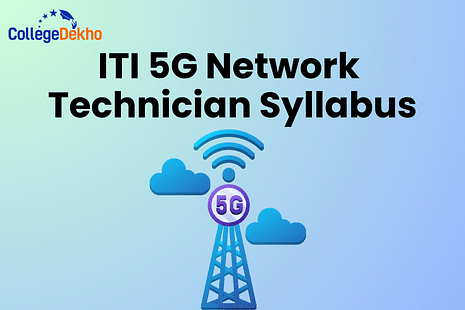
The 5G Network Technician course is a full-time, one-year course that trains students in Professional Skills, Professional Knowledge, and Employability Skills relevant to the job. The course covers all aspects of becoming a Network Technician.
The course consists of domain and core sections. The Domain sections focus on professional skills, including trade theory and practical applications, while the Core sections highlight life skills such as employability skills. Upon finishing the training program, students are awarded a National Trade Certificate (NTC) by DGT.
Students in the one-year training program will learn to implement safe working practices, environmental regulation, and housekeeping. They will also gain skills in constructing, testing, and verifying analogue communication links and digital modulation techniques. Additionally, they will be trained in testing and diagnosing computer hardware networking and security, implementing fibre crimping and mechanical splicing, testing wireless networks, and working with 5G simulation software. Furthermore, students will learn to identify, select, and test 5G hardware components, troubleshoot 5G network use cases, test 5G smart devices, and work with wireless devices and enterprise monitoring tools. They will also learn to classify and oversee network system protection, support RF link performance, and work with security teams to evaluate threats and comply with security configuration standards. Finally, they will be trained to maintain operating BTS sites.
ITI 5G Network Technician Syllabus
The syllabus for an ITI (Industrial Training Institute) 5G Network Technician program is typically divided into various subjects/modules taught over semesters. Students will gain the theoretical knowledge, and practical skills to work as proficient 5G Network Technician after completing the program.
Students can also access the Official ITI 5G Network Technician Syllabus in this brochure:
Official ITI 5G Network Technician Syllabus PDF
The detailed syllabus for the ITI 5G Network Technician course has been shared below:
Semester 1 | |
|---|---|
Trade Theory | |
Access Control Policies
| Safety
|
Security Policies
| Compliance Policies
|
Quality of Service (QoS) Policies
| Wireless Communication
|
5G Hardware Components
|
5G use cases and services
|
Semester 1 | |
|---|---|
Trade Practical | |
Safety
| Implementing Access Control Policies
|
5G Hardware Components
| 5G Network
|
Implementing Quality of Service (QoS) Policies
| Implementing Compliance Policies
|
Wireless Communication
| RFSIM 5G Simulation Software
|
Semester 2 | |
|---|---|
Trade Theory | |
Understanding the product or service
| 5G Network Architecture
|
Test and Tweak wireless devices
| 5G Smart Device
|
|
|
|
|
Semester 2 | |
|---|---|
Trade Practical | |
Analyzing 5G Network
| Test and Tweak wireless devices
|
Troubleshooting a 5G network:
| 5G Smart Device
|
Setting up and configuring a wireless switch
| Troubleshooting wireless connectivity issues
|
Testing the performance of a wireless network
Configuring a wireless bridge:
| |
ITI 5G Network Technician Eligibility Criteria
Students interested in pursuing a diploma in ITI 5G Network Technician course must have at least a class 10th qualification. ITI's 5G Network Technician course eligibility requirements are listed below:
- Passed 10th Class (recognised board and institute)
- Candidates must be able to speak both English and Hindi fluently.
Understanding the syllabus is essential and It's really important to do well in the ITI 5G Network Technician course. Make sure to plan your study schedule in a way that covers all the topics mentioned in the syllabus. Don't forget to practice and revise regularly to understand the concepts. And if you ever find something difficult to grasp, don't hesitate to ask your teachers for help!
Related Links:
If you have any queries, write to our experts on the CollegeDekho QnA Zone . For personalised assistance with admission to your chosen MBA college, fill out our Common Application Form (CAF) or call our helpline number 1800-572-9877.
Are you feeling lost and unsure about what career path to take after completing 12th standard?
Say goodbye to confusion and hello to a bright future!

FAQs
5G ITI course topics may include network security, 5G strategy for business leaders, and how to best incorporate the transition to 5G. Learning more about this field can supplement your knowledge of computer programming and information technology.
A 5G Technician for 5G Networks installs the necessary equipment at 5G network sites to ensure power supply to 5G network and transmission equipment.
The CTS offers a one-year 5G Network Technician trade course, which is available nationwide through a network of ITIs. The course covers both the Domain area and the Core area.
Was this article helpful?


















Similar Articles
Private ITI Colleges in Lucknow: Top Colleges, Fees, Eligibility, Pass Percentage
Government ITI Colleges in Nagpur: Admission Process, Eligibility, Fees and Courses
ITI Colleges in Jaipur: Popular Trades, Seat Matrix, Course Fees
Top ITI Colleges in Pondicherry: Colleges List, Eligibility, Admissions
Kerala ITI Admission 2025: Dates, Application Form, Counselling Process, Merit List, Fee Details
Andhra Pradesh ITI Admission 2025: Application Form, Eligibility, Merit List, Counselling, Trades